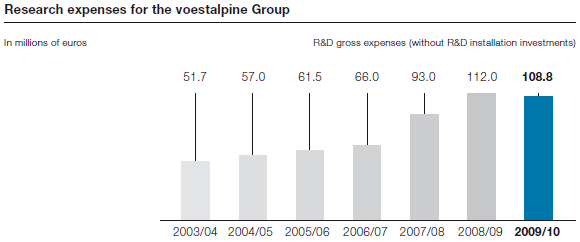Development of R&D key figures
Despite the economic crisis, the voestalpine Group’s expenses for research and development remained at a very high level. The R&D budget, which was at EUR 111.9 million for the past business year (thus precisely corresponding to the actual 2008/09 figure, the absolute record thus far), was not completely exhausted due to this sector’s ongoing efficiency gains so that at EUR 108.8 million, the actual R&D expenses represented a slight decline by 2.8%. The estimated R&D expenses for the current business year amount to EUR 111 million; this means that after increasing its innovation expenses four-fold in the last ten years, the voestalpine Group has kept them at the all-time high for already three consecutive years, even after the onset of the economic crisis.

The development of the research ratio (R&D expenses to total revenue) should also be highlighted. This key figure went up in the past business year from 0.96% to 1.27%, while the R&D coefficient (expenses measured by added value) rose just as significantly from 2.58% to 3.42%.
voestalpine patents again up
The trend with regard to patents was equally gratifying: Running against the worldwide declining number of new patent registrations in the 2009 calendar year due to the economic crisis1 (globally by more than 4%, in Europe by more than 8%), the voestalpine Group was even able to further increase the number of its patents. Despite comprehensive streamlining of the patent portfolio by about 260 proprietary/patent rights, the total number rose in the past year by roughly 200 or about 6% to 3,470 patents (applied for and granted).
Expansion of the R&D network
International technology and quality leadership in sophisticated and high quality sectors requires a foundation based on intensive (application-oriented) fundamental research. As the most research-intensive domestic industrial corporation, voestalpine is also an important industrial partner—far beyond the borders of Austria—of 80 universities and university research institutes. Furthermore, the Group is a participant in ten projects of the Austrian COMET competency center program and 15 Christian Doppler laboratories.
By way of their cooperation with the voestalpine Group, university R&D partners receive more than 10% of the voestalpine research and development budget.
Focal points of our R&D strategy
Sustainable innovation leadership is based not only on focusing the Group’s research activities on ongoing product and process improvements, but identifying very long-term, global developments at as early a stage as possible, analyzing them, and translating them into concrete focal areas of activity. The long-term R&D focus is particularly on materials-relevant aspects of the energy, mobility, and resources sectors, which were already at the center of our research and development activities during the business year 2009/10. For example, development of components made of innovative high-temperature materials, as well as special applications for the solar energy, wind power, and thermal energy generation sector have been driven forward.
A crucial aspect of our competitiveness is the cross-divisional, consistent collaboration across the entire Group that comprises not only materials competence, but key know-how in processing techniques, including the bonding of materials, for example, through newly developed welding technologies.
-
For details on those innovations that were successfully realized in the past year (for example, new lightweight construction technologies for automobile construction or continuing optimization of high-quality high-speed switches), we refer to the detailed information contained in the quarterly reports on the business year 2009/10.
1 Sources: national and international patent offices.


